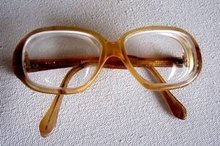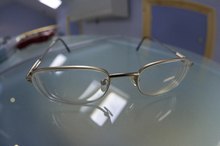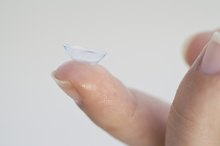Problems With the Anti-Reflective Coating on Glasses
Anti-reflective coatings are applied to eyewear lenses to block or reduce external and internal reflective light 2. This coating reduces glare so your eyes are are more visible behind your lenses. Coated lenses improve night vision and increase user comfort when viewing a computer screen. An anti-reflective coating adds to the value of your eyewear; however, this coating can present some problems for the wearer.
Mechanics
The anti-reflective coating consists of layers of metal oxides applied to the front and back of glass, plastic or polycarbonate lenses. These micro-thin layers consist of zirconium-dioxide, titanium-dioxide, aluminum-oxide or silica dioxide. Anti-reflective coatings can be applied to the back of sunglass lenses 2. This eliminates sunlight reflections that occur when the sun is behind the wearer. Some anti-reflective coatings include a "hydrophobic" surface layer used to eliminate water spotting and make it easier to clean the lenses 2. Your AR coating may have an "oleophobic" surface layer designed to keep skin oils from accumulating on the lenses.
- The anti-reflective coating consists of layers of metal oxides applied to the front and back of glass, plastic or polycarbonate lenses.
Lens Crazing
How to Repair a Scratch on Eyeglass Lenses With Anti-Reflective Coating
Learn More
Lens crazing can occur during the lens finishing process at the optical laboratory. This damage can be caused by heat or stress caused from assembling the eyewear. The lens' AR coating should be stripped by the lens personnel and reapplied. If the lens material has been damaged, the coating process must begin anew with another lens. A lens affected by crazing may have cracking or dimpling. Most anti-reflective coating manufacturers offer a one- or two-year warranty on their products, according to certified optician Renee Bentley, ABOC. She advises her clients to avoid leaving their glasses in an hot environment, such as in the car, during sunny weather.
- Lens crazing can occur during the lens finishing process at the optical laboratory.
Lens Scratching
Dirt and grit around the optical equipment can transfer to AR coated lenses during the finishing process. Personnel must handle the processed lenses carefully to avoid scratching or dirtying the lenses. AR coated lens need more frequent cleanings since smudges and dirt are more apparent. The lenses should be cleaned at least once a day. Clean the lenses with a mild nonlotion based detergent and lukewarm water. There are cleansing agents specifically designed for anti-reflective coatings 2. Dry the lenses with a clean, soft, lint-free towel or an AR cleaning cloth. Bentley advises her clients to avoid using paper products on their lenses. "Any wood-based product can damage the coating and scratch the lens," she explains.
- Dirt and grit around the optical equipment can transfer to AR coated lenses during the finishing process.
- Bentley advises her clients to avoid using paper products on their lenses. "
Decreased Impact Resistance
Photochromic Vs. Polarized Sunglasses
Learn More
Optical professionals recommend using a good hard-coat underneath an AR coating. The hard-coat improves the adhesion of the AR coating and makes the coating less likely to scratch. However, hard-coatings and AR coatings may make a lens more brittle and undermine the lens' impact resistance. The optical lab can use a soft primer to cushion the lens and mitigate the shortcomings of the hard-coat. The energy of impact is absorbed through the primer on the back surface, where cracks are most often initiated preventing cracks from continuing through the lens.
- Optical professionals recommend using a good hard-coat underneath an AR coating.
- The optical lab can use a soft primer to cushion the lens and mitigate the shortcomings of the hard-coat.
Related Articles
References
- All About Vision; Eyeglass Lens Coatings: Anti-Reflective Coating, Scratch-Resistant, Anti-Fog and UV; Liz DeFranco, ABOC, NCLS, et al.
- "20/20": Crossing the Finish Line with AR Coatings
- Ross J, Bradley A. Visual performance and patient preference: a comparison of anti-reflection coated and uncoated spectacle lenses. J Am Optom Assoc. 1997;68(6):361-6.
Writer Bio
Carolyn Ritter has been writing professionally since 1995. She has provided online, on-air and printed content for hospital, travel and insurance industries in marketing and public-relations roles. She has been published in "The Bread" magazine. Ritter holds a Bachelor of Arts in English from Indiana University.









